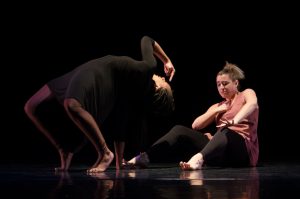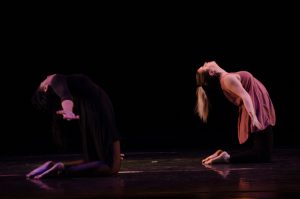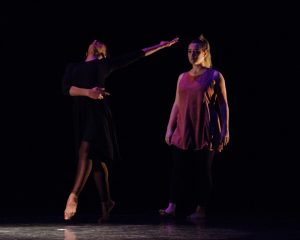Creative thinking and collaboration were the answers to an unfortunate overlap in scheduling between this year’s Dance 44 concert and the American College Dance Association’s (ACDA) East-Central regional conference. The conflicting circumstance caused senior dancers Emily Mejicano-Gormley and Nia Stringfellow to combine their previously-performed and stunning solo works, “Memory” by Mejicano-Gormley and “The Will” by Stringfellow, into a duet. The result is breathtaking and award-winning.

Relying on their imagination to meld individual pieces that deal with similar themes of pain and resolve, Mejicano-Gormley and Stringfellow put their works together and aptly named it, “The Will/Memory.” With some coaching and choreography help from Professors Matt Farmer and Linda Graham, the two practiced the new original for three months this spring. They debuted it at a place and time both were available to perform together — at the University of Illinois for the ACDA Central regional conference in mid-March, after Dance 44 was complete.
“Since Dance 44 was at the same time as our regional ACDA conference (Hope is a member of the East-Central region), we had to go outside of our region to enter works for adjudication by the ACDA,” explains Graham, the Dorothy Wiley DeLong Professor of Dance. “We had hoped to get both solos in the Central conference but when schools go outside their region, they have to see what is left over after in-region schools take their slots. Consequently, by the time registration opened for the Central region, all but one adjudication slot had been taken by in-region schools. So I literally filled out the form and sat there, at my computer, watching the clock, and the moment the outside registration opened, I hit ‘enter.’ I had to snag it fast.”
“Personally, I thought the solos would work incredibly well juxtaposed with some crafty fusion.”
With only one slot available and two worthy solos to offer, a decision had to be made. Mejicano-Gormley and Stringfellow were asked to work together. “Personally, I thought the solos would work incredibly well juxtaposed with some crafty fusion,” said Graham.

While “The Will/Memory” was created out of a scheduling necessity, Mejicano-Gormley and Stringfellow are the reasons the original work received prestigious accolades. “The Will/Memory” was chosen as one of 11 pieces (out of 44) to be performed during the ACDA Central region’s Gala Concert. Additionally, the piece received one more unexpected recognition when it was named an alternate for the national ACDA National College Dance Festival this June at the John F. Kennedy Center for Performing Arts in Washington, D.C. Each region selects two finalists and two alternates for the national festival.
What makes each unconventional step toward getting this deeply-moving dance to the regional, and maybe national, stage even more impressive is that Mejicano-Gormley and Stringfellow represented one of only two private liberal arts colleges at the conference. The other 25 schools present are all universities with professional choreographers.
“To have a dance piece created by two students placed on the same level as works of professional choreographers is both outstanding and an honor.”
“To have these students’ works accepted to both the Gala concert and as an alternate to the national performance at the Kennedy Center is a true testament to both the training in the dance department and the students’ artistic talent and hard work,” said Farmer, associate professor of dance and chair of the department. “To have a dance piece created by two students placed on the same level as works of professional choreographers is both outstanding and an honor.”

Farmer started working with the two stellar dancers last December to help develop smooth transitions from one solo to the other inside the duet. “I would make a suggestion and talk about my reasons why I suggested this entry point or that transition, but I’d always ask, ‘Are you okay with that?’ The work was their inspiration so it was important I ask. But Nia and MG were always up for everything.”
Mejicano-Gormley and Stringfellow each created their solos for last year’s student-choreographed dance concert. Their inspiration for each piece emanated from the experience of wrestling with personal hardships. Stringfellow’s “The Will” expresses tenacity in the face of oppression, while Mejicano-Gormely’s “Memory” unpacks the difficulties in both leaving and moving forward. Their ability to combine and express deeply sensitive themes for hundreds of people demonstrates dedication to their art.
“Each step of creating this work has been a graceful surprise.”
“I think we were ready to explore our own solo works within this piece more because we had each other,” explains Mejicano-Gormley, a biology major and dance minor. “Each step of creating this work has been a graceful surprise,” acknowledged Stringfellow, an exercise science major and dance minor.
Graham calls “The Will/Memory” “an artistic gestalt — a duet that conveyed a universal truth deeply and rightly through the unique and ordinary.” Three adjudicators said the dance “represents a negotiation, standing emblematic to their truths,” that it “worked at multiple layers, slicing and etching with heart-wrenching pain,” and “it makes space with dignity and empathy for the tensions of race.”
As they dance with and near each other for more than nine minutes, Mejicano-Gormley and Stringfellow never truly make full eye contact. The two dancers almost see each other, but a new twist or turn keeps each from discovering the other. At the conclusion, the dancers eyes meet and the moving emotion of “The Will/Memory” makes way for hope. This is part of Mejicano-Gormley and Stringfellow’s brilliance. In the end, the dancers and the dance reveal that the look of hope is a powerful thing.
Costume design by Emily Mejicano-Gormley and Nia Stringfellow. Music by Clyde Otis and Sara Bareillis. Lighting design by Erik Alberg.

